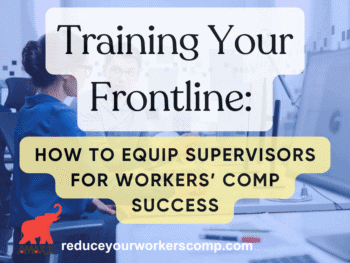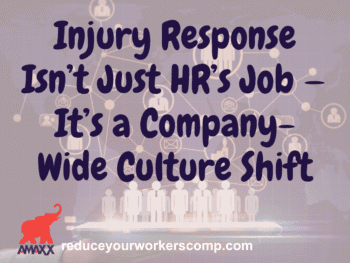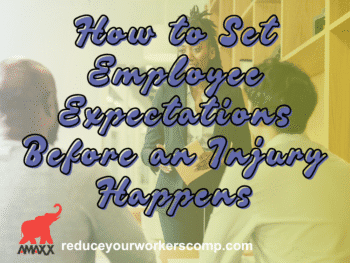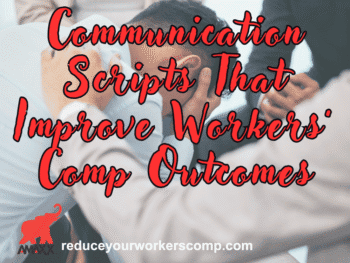
Imagine you work in a plastics factory where your company manufactures plastic molds used for supermarket items like salad containers and salsa cups. You’re an average employee with ambitions to advance within the company. One day, while carrying a heavy box, you experience a sharp pain in your shoulder. You report this injury to your supervisor, who could respond in one of two ways:
- Supervisor A’s Response:
“What do you mean, you hurt your shoulder? We just got new production demands, and we’re already behind as it is. I’m going to have to fill out all these forms—what a pain. I’m sure it doesn’t really hurt that much; just forget about it and get back to work. Oh, by the way, if you file that claim, you know that promotion you were thinking about? That’s not going to work out too well for you.”
- Supervisor B’s Response:
“Okay, sorry you got hurt. Are you in a lot of pain? Let’s go to my office for some privacy, and we’ll take a closer look. I want to make sure you get medical attention right away, so I’ll call our injury triage hotline and connect you with a medical professional to discuss the injury. If you need to go to a clinic, I’ll take you there myself. Then, we’ll talk about how we can work together to accommodate your injury and help you return to the team as soon as possible.”
Click Link to Access Free PDF Download
“9-Element Blueprint To Create Your Workers’ Comp Employee Brochure”
Analyzing the Impact of Each Response
The injury in these two scenarios is the same, but the potential outcomes could not be more different. Let’s consider what might happen next in each case:
- Likelihood of Injury Getting Worse:
- In Scenario A, the dismissive response from Supervisor A increases the likelihood that the employee’s injury could worsen. The lack of immediate medical attention and pressure to continue working despite the injury could exacerbate the condition, leading to more severe health issues and potentially higher medical costs.
- In Scenario B, Supervisor B’s proactive approach in seeking immediate medical attention reduces the risk of the injury getting worse. By ensuring the employee receives the necessary care promptly, there’s a better chance for a quicker and more complete recovery.
- Likelihood of Hiring an Attorney:
- In Scenario A, the employee is more likely to feel neglected and undervalued. The lack of support and the implied threat regarding the promotion could lead the employee to seek legal counsel to protect their rights and secure compensation for their injury.
- In Scenario B, the supportive and caring approach by the supervisor decreases the likelihood of the employee feeling the need to hire an attorney. When employees feel their employer is looking out for their well-being, they are less inclined to take legal action.
- Likelihood of Seeking Revenge or Delaying Return to Work:
- In Scenario A, the employee may feel angry, resentful, and demotivated. This could lead to a lack of engagement or even attempts to sabotage productivity as a form of revenge. The employee may also be in no hurry to return to work, extending their time off and increasing costs for the employer.
- In Scenario B, the employee is more likely to feel valued and supported, fostering a sense of loyalty and willingness to return to work as soon as they are medically cleared. This response encourages a more positive outcome for both the employee and the employer.
The Business Case for Compassionate Responses
While it’s easy to see that Supervisor B’s response “feels better” from an employee perspective, senior management often requires more than just a feel-good factor to drive change. The key to effective injury management is to leverage independent, scientific research that demonstrates the monetary value of appropriate supervisor responses. Here’s why adopting Supervisor B’s approach can be beneficial:
- Reduced Costs and Legal Risks: Compassionate and immediate responses to injuries reduce the likelihood of litigation and associated legal costs. By preventing injuries from worsening and minimizing disputes, companies can significantly reduce their workers’ compensation costs.
- Increased Employee Satisfaction and Retention: Employees who feel cared for are more likely to stay with the company, reducing turnover and the costs associated with hiring and training new staff.
- Improved Productivity and Morale: A workplace culture that prioritizes employee health and safety fosters higher morale, leading to increased productivity and a more positive work environment.
Conclusion
The response of a supervisor to an employee’s injury can set the tone for the entire recovery and return-to-work process. As demonstrated in the scenarios above, a supportive and proactive approach not only benefits the employee by ensuring they receive timely medical care but also serves the employer by reducing costs, minimizing legal risks, and maintaining a positive workplace culture. Employers and workers’ compensation service providers should be motivated to implement strategies that align with the best practices for injury management, supported by independent research and proven outcomes.
For more insights and strategies on managing workplace injuries effectively, consider exploring resources like the Injury Management Results (IMR) software developed by Amaxx LLC, which simplifies the implementation of best practices for employers and ties results to a Critical Metrics Dashboard.
By embracing these practices, employers can create a safer, more supportive workplace that benefits everyone involved.

Contact: mstack@reduceyourworkerscomp.com.
Workers’ Comp Roundup Blog: http://blog.reduceyourworkerscomp.com/
Injury Management Results (IMR) Software: https://imrsoftware.com/
©2024 Amaxx LLC. All rights reserved under International Copyright Law.
Do not use this information without independent verification. All state laws vary. You should consult with your insurance broker, attorney, or qualified professional.

















